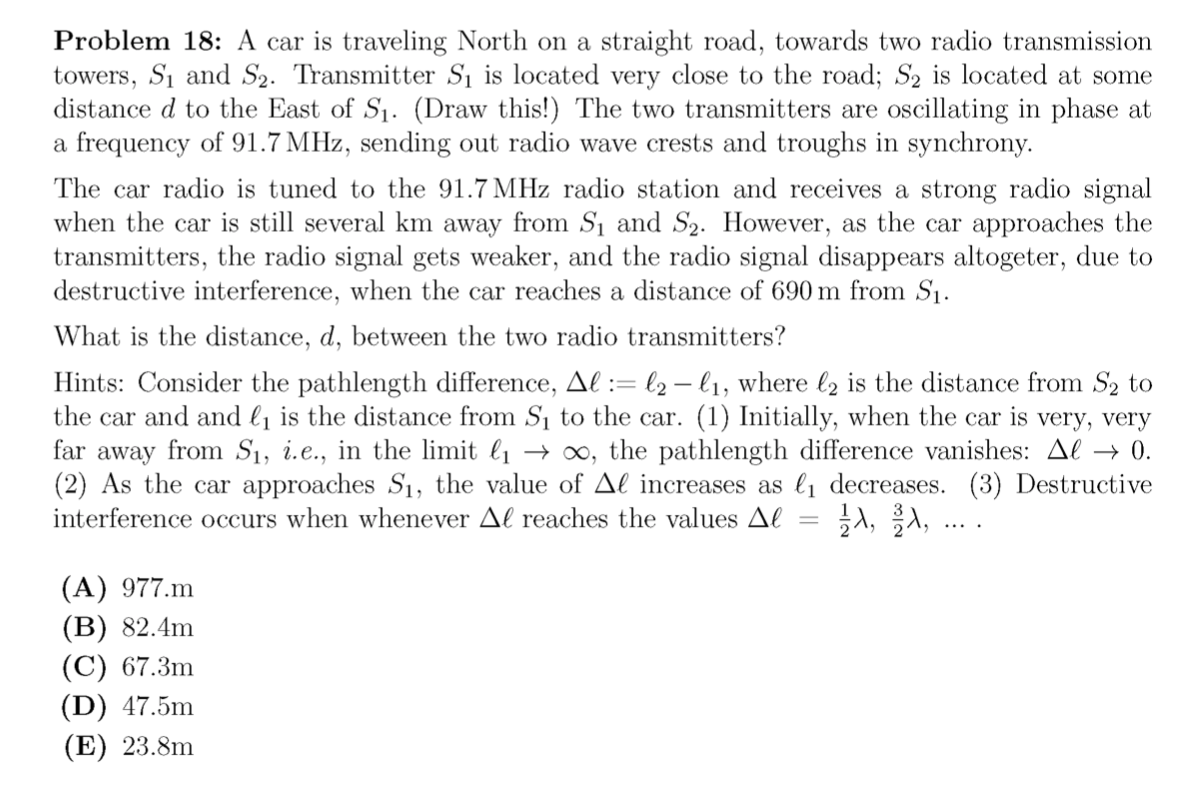Question

Transcribed Image Text:Problem 18: A car is traveling North on a straight road, towards two radio transmission
towers, S1 and S2. Transmitter S1 is located very close to the road; S2 is located at some
distance d to the East of S1. (Draw this!) The two transmitters are oscillating in phase at
a frequency of 91.7 MHz, sending out radio wave crests and troughs in synchrony.
The car radio is tuned to the 91.7 MHz radio station and receives a strong radio signal
when the car is still several km away from Sı and S2. However, as the car approaches the
transmitters, the radio signal gets weaker, and the radio signal disappears altogeter, due to
destructive interference, when the car reaches a distance of 690 m from S1.
What is the distance, d, between the two radio transmitters?
Hints: Consider the pathlength difference, Al := l2 – l1, where l2 is the distance from S2 to
the car and and l1 is the distance from S1 to the car. (1) Initially, when the car is very, very
far away from S1, i.e., in the limit l1 → ∞, the pathlength difference vanishes: Al → 0.
(2) As the car approaches S1, the value of Al increases as l, decreases. (3) Destructive
}A, A,
interference occurs when whenever Al reaches the values Al
(A) 977.m
(B) 82.4m
(C) 67.3m
(D) 47.5m
(E) 23.8m
Expert Solution
This question has been solved!
Explore an expertly crafted, step-by-step solution for a thorough understanding of key concepts.
This is a popular solution
Trending nowThis is a popular solution!
Step by stepSolved in 5 steps with 5 images

Knowledge Booster
Similar questions
- You have been taken to the emergency room. To get a constant update on your vital signs, equipment is attached to you, including a pulse oximeter. The pulse oximeter shines two LEDs on your finger to test how much oxygen is in your blood. One LED transmits in infrared (921 nm) and one transmits in visible red (632 nm). What are the frequencies of these LEDs? Red: (Hz) Infared: (Hz)arrow_forwardA distant galaxy is simultaneously rotating and receding from the earth. As the drawing shows, the galactic center is receding from the earth at a relative speed of ug = 2.30 × 106 m/s. Relative to the center, the tangential speed is V₁ = 0.310 × 106 m/s for locations A and B, which are equidistant from the center. When the frequencies of the light coming from regions A and B are measured on earth, they are not the same and each is different from the emitted frequency of 9.296 × 10¹4 Hz. Find the measured frequency for the light from (a) region A and (b) region B. (Give your answer to 4 significant digits. Use 2.998 × 108 m/s as the speed of light.) (a) Number (b) Number i 9.21E14 9.23E14 יזע Galaxy Units Hz Units Hz ING Earth די. Barrow_forwardLight is prepared so that it is polarized at 15.4 degrees with an intensity of 0.553 W/m2. The light passes through a polarizer oriented to pass polarization at an angle of 65.2 degrees and then through a second polarizer oriented to pass polarization at 90.0 degrees. What is the intensity in W/m2 of the light after passing through the second polarizer? (Enter answer with 3 digits right of the decimal.arrow_forward
- A distant galaxy is simultaneously rotating and receding from the earth. As the drawing shows, the galactic center is receding from the earth at a relative speed of UG = 1.30 × 106 m/s. Relative to the center, the tangential speed is X VT = 0.480 × 106 m/s for locations A and B, which are equidistant from the center. When the frequencies of the light coming from regions A and B are measured on earth, they are not the same and each is different from the emitted frequency of 6.737 x 10¹4 Hz. Find the measured frequency for the light from (a) region A and (b) region B. (Give your answer to 4 significant digits. Use 2.998 × 108 m/s as the speed of light.) (a) Number (b) Number A יזע Galaxy Earth די B Units Unitsarrow_forwardPlease help with A, B, and Carrow_forwardA distant galaxy is simultaneously rotating and receding from the earth. As the drawing shows, the galactic center is receding from the earth at a relative speed of ug = 2.30 × 106 m/s. Relative to the center, the tangential speed is v₁ = 0.310 × 106 m/s for locations A and B, which are equidistant from the center. When the frequencies of the light coming from regions A and B are measured on earth, they are not the same and each is different from the emitted frequency of 9.296 × 10¹4 Hz. Find the measured frequency for the light from (a) region A and (b) region B. (Give your answer to 4 significant digits. Use 2.998 × 108 m/s as the speed of light.) (a) Number (b) Number Units Units יזע Galaxy ING Earth די. Barrow_forward
- Problem: A 3.46m diameter university communications satellite dish receives TV signals that have a maximum electric field strength (for one channel) of 7.87μV/m Part a: What is the intensity, in watts per squared meter, of this wave? Part b: What is the power, in watts, received by the antenna? part c: If the orbiting satellite broadcasts uniformly over an area of 1.50×1013m2(a large fraction of North America), how much power, in watts, does it radiate?arrow_forwardProblem 4: Consider the 100-MHz radio waves used in an MRI device. Part (a) What is the wavelength, in meters, of these radio waves? Part (b) If the frequencies are swept over a ±14 MHz range centered on 100 MHz, what is the minimum, in meters, of the range of wavelengths emitted? Part (c) What is the maximum, in meters, of this wavelength range?arrow_forward
arrow_back_ios
arrow_forward_ios